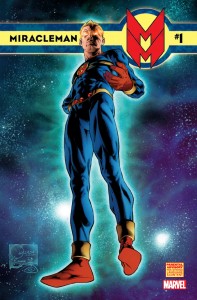 This week, Marvel comics began selling reprints of Miracleman. Miracleman #1 includes the eleven page prologue story “The Invaders From The Future”, originally published in 1985, along with “A Dream Of Flying”, parts 1 and 2, which were originally published in 1982 by Warrior magazine. Miracleman creator, Mick Anglo, wrote the prologue. Alan Moore, who chose to have his name stripped from this reprint, wrote “A Dream Of Flying”. Indeed, if you look at the inside cover where the author typically is listed, it instead says “The Original Writer”. It’s like Moore has never heard of Alan Smithee.
This week, Marvel comics began selling reprints of Miracleman. Miracleman #1 includes the eleven page prologue story “The Invaders From The Future”, originally published in 1985, along with “A Dream Of Flying”, parts 1 and 2, which were originally published in 1982 by Warrior magazine. Miracleman creator, Mick Anglo, wrote the prologue. Alan Moore, who chose to have his name stripped from this reprint, wrote “A Dream Of Flying”. Indeed, if you look at the inside cover where the author typically is listed, it instead says “The Original Writer”. It’s like Moore has never heard of Alan Smithee.
I’ve never read any of the Miracleman books before. My only exposure to them was watching Rob one night in a drunken Ebay war to track down the fabled 15th issue, where I gather one of the good guys goes bad and does something truly heinous to the city of London and it’s received more poorly than when Superman and Zod do the same thing in Man Of Steel. However, having read much of Moore’s other work, I can see the appeal the Miracleman story must have had for him: Golden Age hero whose story he re imagines in the early 80s, when the apple cheeked Boy Scout heroes of the 50s could be more thoroughly examined for their dark undersides. It is a theme Moore has visited often since, in Watchmen and as recently as the Image Comics, originally as Awesome Comics, reboot of Supreme.
As the back matter of this issue explains, Miracleman was essentially lifted from Fawcett Comics Captain Marvel in the mid-fifties. In fact, when Mick Anglo first wrote the character, it was called Marvelman. Conceived as a “science-based” version of Captain Marvel, young Mick Moran utters the word “Kimota!” (atomic, spelled incorrectly and backwards) and is granted atomic powers by an astrophysicist named Guntag Borghelm, who has somehow unlocked “the key harmonic to the universe”. My instinct here is to make a snarky comment about how that should probably have netted Borghelm a Nobel prize, instead of obscurity and the desire to talk to young boys at night, but Moore anticipates that in his retelling. As Moran recounts his past to his disbelieving wife, she laughs at him. Moore has set Moran up as a tormented adult, who for the past couple decades could not remember his identity as Miracleman, but is haunted at night by “a dream of flying”. When circumstances conspire for him to remember and thus come back into the power he has left behind, you can palpably feel the tension of the character abate, while at the same time his wife must now cope with the surreal. Mick Moran may now be whole, but the life of his wife, and that of an unnamed character who is introduced in the final panels of the story, begins to unravel. The premise is as compelling in 2014 as I’m sure it must have been in 1982.
Joe Quesada drew the cover for the reprint. Miracleman stands imperious, glowing, practically vibrating off the page with his barely contained power. However, the pencils of Garry Leach in the interior story are more nuanced. Each character bursts with complex expression and emotion, from the unbridled joy on Moran’s face as he reassumes the mantle of Miracleman, to doubt and fear on wife Liz’s face, when Mick comes home after a long day at work barely recognizable, except by her heart.
If you haven’t read these stories before, I would highly recommend these reprints as a place to jump on. The graphic novel compilations are still incredibly difficulty to come by and, unless you are willing to sit in front of Ebay with one hand on your mouse and the other on a bottle of Jack Daniels the way Rob was in 2003, you’re not going to easily find the original issues. Collectors – I’m sorry your original prints are tumbling in value as I type, but it’s worth it to have the quality of story back out in active circulation. Do yourself a favor and pick this up.
 Podcast RSS Feed
Podcast RSS Feed iTunes
iTunes Google Play
Google Play Stitcher
Stitcher TuneIn Radio
TuneIn Radio Android
Android Miro Media Player
Miro Media Player Comics Podcast Network
Comics Podcast Network